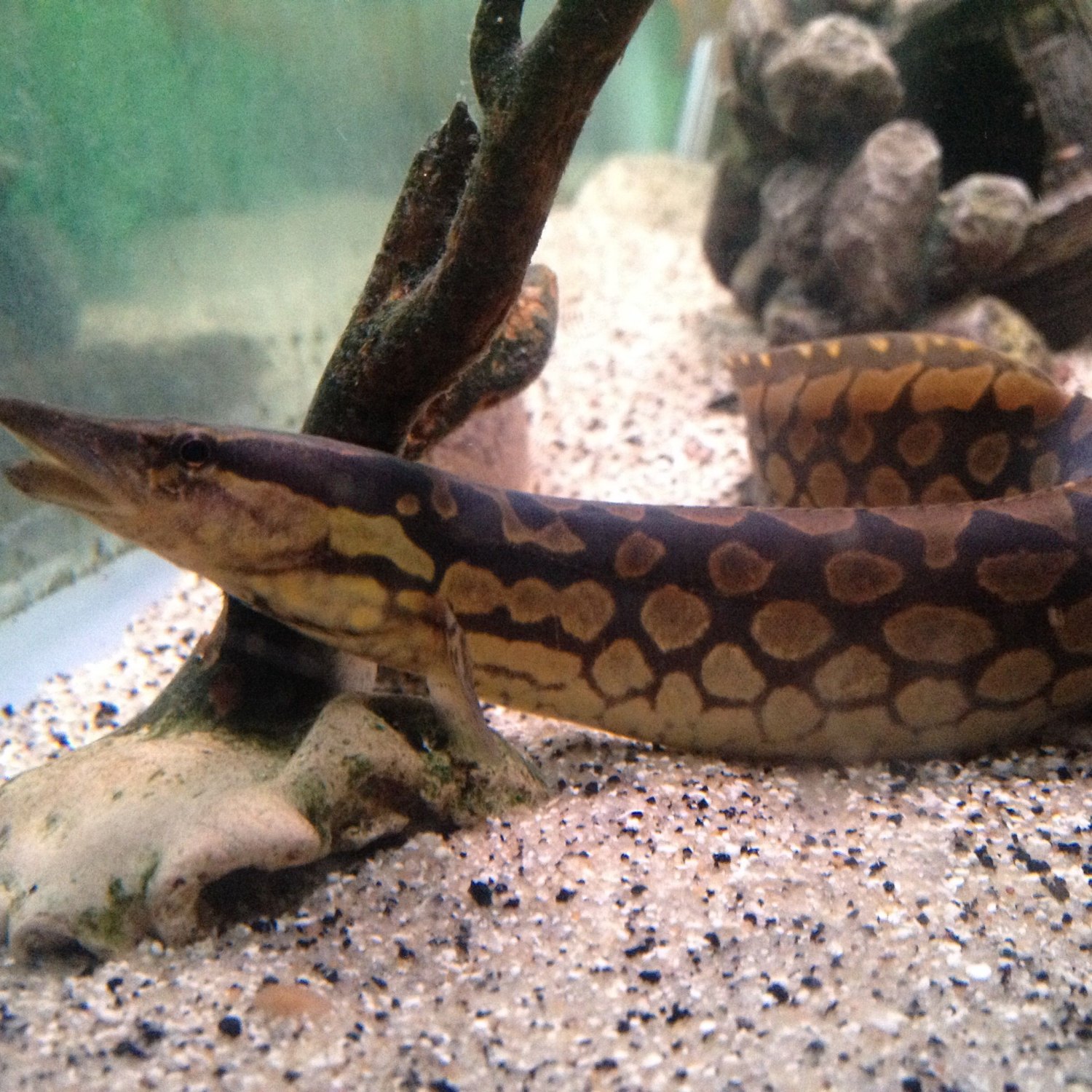
Tire Track Eel
Up to 35 inches (90 cm)
. The Tire Track Eel, found in rivers and swamps, can grow up to 35 inches and has a distinct snake-like body with small fins. Named for its track-like markings, this member of the Mastacembelidae family is popular among aquarium enthusiasts for its unique appearance and behavior. Learn more about this fascinating elongated fish and consider adding it to your tank!
Animal Details Summary:
Common Name: Tire Track Eel
Kingdom: Animalia
Habitat: Freshwater
Tire Track Eel: The Fascinating Creature of Southeast Asia
Imagine walking along a river in Southeast Asia and suddenly coming across what appears to be a tire track imprinted in the sand. But, upon closer inspection, you realize that it is actually an animal – the Tire Track Eel. Native to countries such as India, Thailand, Cambodia, Vietnam, and Indonesia, this elongated fish with its distinctive snake-like pattern is a fascinating creature that has captured the attention of people around the world. Its scientific name, Mastacembelus armatus, is derived from the Greek words 'mastax' meaning jaw and 'embolos' meaning tooth, which is a testament to the powerful jaws and sharp teeth of this carnivorous fish Tire Track Eel.With its unique features and interesting behavior, the Tire Track Eel has become a popular choice for freshwater aquariums. While this creature may not be as flashy or colorful as other tropical fish, its mysterious nature and adaptability make it a standout in the underwater world. In this article, we will dive deep into the world of the Tire Track Eel and uncover its surprising characteristics that make it a must-know for any animal enthusiast.
Family and Habitat
The Tire Track Eel belongs to the family Mastacembelidae, also known as the spiny eels. They are known for their elongated bodies and unique patterns that resemble the tracks of a tire, hence the common name. These eels are found in freshwater habitats such as rivers and swamps, and can often be spotted hiding in the muddy areas along the banks.Their ability to adapt to various water conditions makes them a popular choice for freshwater aquariums. However, due to their size, they require large tanks with plenty of hiding places to feel secure. This is especially important as they can become territorial and aggressive towards other fish if they feel threatened Tiger.
Physical Appearance
The Tire Track Eel is easily recognizable by its dark brown or black body with a snakelike pattern of light-colored lines. This unique pattern serves as camouflage, helping them blend in with their surroundings to avoid predators. They have small, stubby fins that do not serve much purpose for swimming but are used more as stabilizers. Their long, cylindrical body shape is specifically designed for burying themselves in the sand, leaving only their head exposed to hunt.These eels are known to grow up to 35 inches (90 cm) in length, making them one of the largest species in the Mastacembelidae family. Their size and shape make them fantastic escape artists, and they are known to squeeze through small gaps in aquarium lids or even jump out of the tank, so it is important to have a secure lid for their tank.
Feeding Habits
Being carnivorous, the Tire Track Eel primarily feeds on small fish, crustaceans, and insects. In their natural habitat, they use their keen sense of smell to hunt at night, burying themselves in the sand during the day. In captivity, they can also be fed live or frozen foods such as bloodworms, brine shrimp, and small feeder fish. It is important to note that these eels have a fast metabolism, so they need to be fed regularly to maintain their health and energy levels.Behavior and Temperament
One of the most interesting behaviors of the Tire Track Eel is its ability to breathe air. They possess a specialized organ called the labyrinth organ, which allows them to take in oxygen directly from the air. This adaptation is necessary as they often live in oxygen-depleted water in their natural habitat. In captivity, they will often go to the water's surface to breathe, which can be a fascinating sight for aquarium owners.Despite their intimidating appearance, Tire Track Eels are generally peaceful and solitary creatures. However, as mentioned earlier, they can become territorial and aggressive towards other fish if they feel threatened. For this reason, they are best kept alone or in large tanks with plenty of space and hiding spots for each fish.
Geographical Distribution
The Tire Track Eel is native to Southeast Asia, particularly in countries such as India, Thailand, Cambodia, Vietnam, and Indonesia. These areas are known for their dense rainforests and expansive network of rivers and swamps, making it the perfect habitat for this elusive creature. They are also commonly found in the aquarium trade, where they are bred in captivity to help conserve their natural populations.Conservation Status
According to the International Union for Conservation of Nature (IUCN), the Tire Track Eel is listed as Least Concern. This means that their population is stable and not currently in danger of extinction. However, their natural habitats are threatened by deforestation and pollution, which can have a negative impact on their survival. It is crucial to support conservation efforts and limit the capture of these eels from the wild to preserve their natural populations.Final Thoughts
In conclusion, the Tire Track Eel is a truly unique and fascinating creature that has captured the hearts of many aquarium enthusiasts. With its distinctive patterns, intriguing behaviors, and adaptability, this eel is a standout in the underwater world. However, it is essential to understand their needs and characteristics before introducing them to captivity. With proper care and attention, they can make a fantastic addition to any freshwater aquarium and continue to awe and inspire people for years to come.

Tire Track Eel
Animal Details Tire Track Eel - Scientific Name: Mastacembelus armatus
- Category: Animals T
- Scientific Name: Mastacembelus armatus
- Common Name: Tire Track Eel
- Kingdom: Animalia
- Phylum: Chordata
- Class: Actinopterygii
- Order: Synbranchiformes
- Family: Mastacembelidae
- Habitat: Freshwater
- Feeding Method: Carnivorous
- Geographical Distribution: Southeast Asia
- Country of Origin: India, Thailand, Cambodia, Vietnam, Indonesia
- Location: Rivers and swamps
- Animal Coloration: Dark brown or black with a light colored, snakelike pattern on its body
- Body Shape: Elongated, snake-like body with small, stubby fins
- Length: Up to 35 inches (90 cm)

Tire Track Eel
- Adult Size: Around 24-35 inches (60-90 cm)
- Average Lifespan: 10-15 years
- Reproduction: Sexual
- Reproductive Behavior: They build nests in the substrate and spawn in the nests
- Sound or Call: Does not produce sound
- Migration Pattern: No specific migration patterns
- Social Groups: Solitary
- Behavior: Nocturnal, secretive
- Threats: Habitat loss, pollution, overfishing
- Conservation Status: Not evaluated
- Impact on Ecosystem: Important role as predators in the freshwater ecosystem
- Human Use: Popular in the aquarium trade
- Distinctive Features: Snake-like appearance, tire track pattern on the body
- Interesting Facts: Can breathe air using a specialized lung-like structure called a labyrinth organ
- Predator: Large fish, birds

Mastacembelus armatus
The Enigmatic Tire Track Eel: A Fascinating Creature of the Freshwater World
From mystical mermaids to fierce sharks, the underwater world is brimming with captivating creatures. However, one species that often goes unnoticed is the mysterious Tire Track Eel. With its snake-like appearance and unique tire track pattern, this eel is a fascinating yet enigmatic creature that inhabits the depths of freshwater bodies.Found in various regions of Southeast Asia, the Tire Track Eel, or scientifically known as Mastacembelus armatus, belongs to the Mastacembelidae family PeaceOfAnimals.Com. It can often be spotted in rivers, streams, and swamps in countries such as Thailand, Myanmar, Malaysia, and Indonesia. The eel's name is derived from its distinct tire track pattern, which resembles that of a tire's tread marks. This pattern, combined with its elongated and slender body, gives it a striking appearance that sets it apart from other freshwater species.
The Tire Track Eel can reach an adult size of around 24-35 inches (60-90 cm), making it one of the largest eel species in captivity. In the wild, they can grow even larger, with some specimens reported to be over 3 feet in length. This impressive size adds to the eel's mystique, making it an attractive species for aquarium enthusiasts.
In terms of lifespan, the Tire Track Eel can live up to 10-15 years, making it a long-lived species compared to other freshwater fish. This, combined with its unique physical characteristics, makes it an ideal pet for those looking for a long-term commitment.
Unraveling the Reproductive Behavior of the Tire Track Eel
Like most freshwater species, the Tire Track Eel reproduces sexually Turaco. However, their reproductive behavior is quite fascinating and sets them apart from other eel species. Instead of laying eggs, these eels build nests in the substrate, such as sand or gravel, and spawn their eggs within it. The eels will often dig deep into the substrate, creating a burrow-like nest for their eggs. This behavior is typical for eels in the Mastacembelidae family, and the Tire Track Eel is no exception.The eel can lay up to 300 eggs in a single spawning event, but they may spawn multiple times throughout the year. The eggs are transparent and sticky, making them adhere to the substrate, ensuring their protection from predators. Interestingly, the male eel is typically responsible for building and guarding the nest, but both male and female take turns caring for the eggs until they hatch.
A Silent Night: The Tire Track Eel's Unique Soundless Nature
While some underwater creatures are known for their loud calls or songs, the Tire Track Eel is a silent species. Unlike other eels, this species does not produce any sounds, making it a quiet inhabitant of freshwater environments. This soundless nature adds to the eel's enigmatic charm, making it a mysterious yet intriguing creature to observe in aquariums.The Tire Track Eel's Journey: A Story of No Migration
Many freshwater species are known for their remarkable migration patterns, but the Tire Track Eel is an exception. This species does not exhibit any specific migration patterns, making them permanent residents of their habitat. They are known to be territorial and solitary creatures, and once they establish their home in a particular location, they stay there for the rest of their lives.Nocturnal and Secretive: Shedding Light on the Tire Track Eel's Behavior
The eel's behavior is perhaps one of its most intriguing qualities. The Tire Track Eel is a nocturnal and secretive creature, meaning it is most active at night and spends most of its time hiding during the day. This behavior is essential for their survival, as it helps them avoid predators and prey on smaller fish and invertebrates under the cover of darkness.The Threats Facing the Tire Track Eel
While the Tire Track Eel may seem like a resilient and solitary species, it is facing several threats in its natural habitat. Like many freshwater species, habitat loss, pollution, and overfishing are the main risks to this eel's survival. Human development and environmental degradation have led to a decline in their population, making them a threatened species in many regions.Conservation Status: A Species in Need of Evaluation
Despite being a popular species in the aquarium trade, the Tire Track Eel's conservation status is currently not evaluated. This lack of assessment highlights the need for further research and conservation efforts to protect this unique freshwater creature.The Tire Track Eel's Role in the Ecosystem
The Tire Track Eel may not be the apex predator of its habitat, but it plays a significant role in the freshwater ecosystem. As predators, these eels help control the population of smaller fish and invertebrates, maintaining a healthy balance in their environment. They are also a vital food source for larger fish and birds, further solidifying their place in the ecosystem.Aquarium Enthusiasts' Favorite: Popular in the Aquarium Trade
With its mysterious nature, striking appearance, and unique behavior, it's no surprise that the Tire Track Eel is a popular species in the aquarium trade. Its elongated and slender body, combined with its distinctive tire track pattern, makes it a visually appealing addition to any aquarium. However, it's essential to note that owning a Tire Track Eel requires careful research and specific care to ensure their well-being.Discovering the Tire Track Eel's Unique Features
The Tire Track Eel is a creature that is full of surprises. Apart from its distinctive tire track pattern and secretive nature, there's more to this eel than meets the eye. One of its most unique features is its ability to breathe air. The Tire Track Eel possesses a specialized lung-like organ called a labyrinth organ, allowing them to consume oxygen from the air when needed. This adaptation is crucial for their survival, especially in oxygen-depleted water or during the dry season.Predators of the Tire Track Eel
Despite being skilled hunters themselves, the Tire Track Eel also has its fair share of predators in the wild. Large fish, such as catfish and pike, are known to prey on this species. Additionally, birds, such as herons and kingfishers, also target the eel as a food source.In Conclusion
The Tire Track Eel may not be a flashy or well-known species compared to other freshwater inhabitants, but it is undoubtedly a fascinating creature worth knowing more about. Its unique features, behavior, and role in the ecosystem make it a valuable species that should be conserved and protected. As humans, it's our responsibility to appreciate and safeguard the diversity of life on our planet, including the enigmatic Tire Track Eel.

Tire Track Eel: The Fascinating Creature of Southeast Asia
Disclaimer: The content provided is for informational purposes only. We cannot guarantee the accuracy of the information on this page 100%. All information provided here may change without prior notice.












